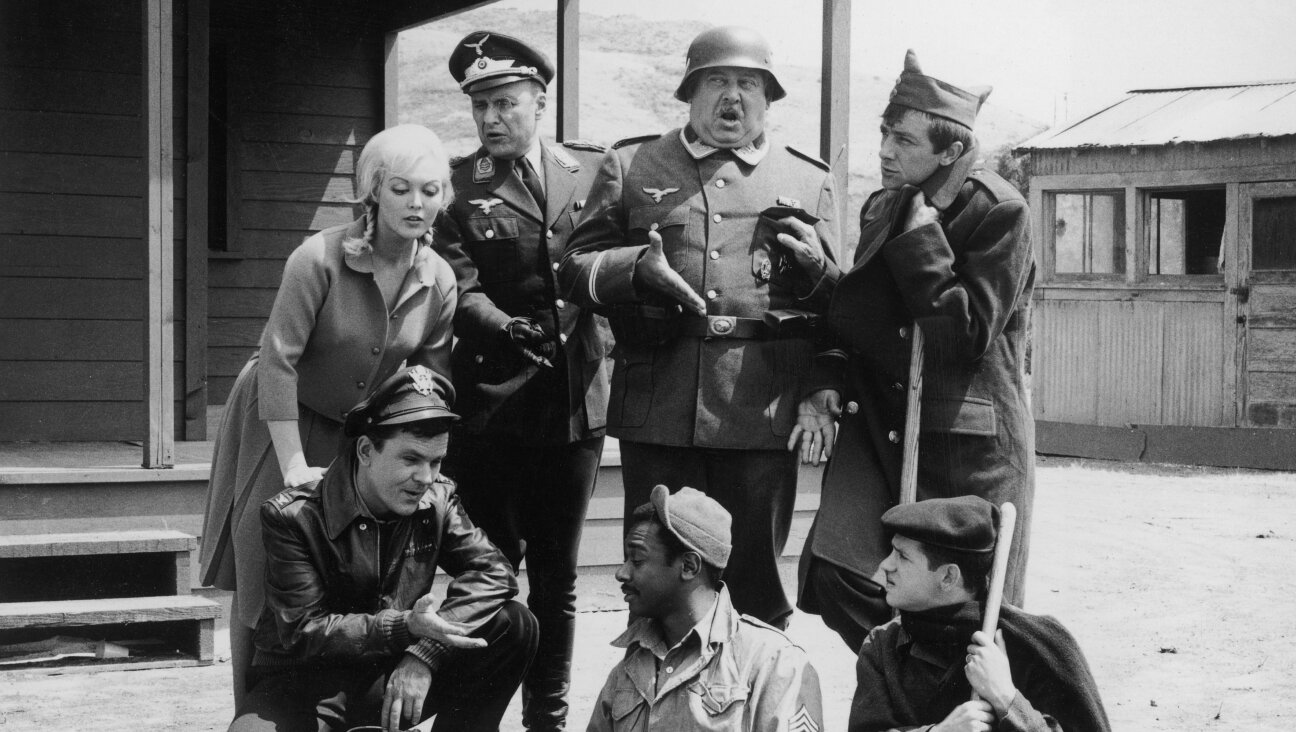The IDF Made This Film 18 Years Ago — Why Hasn’t Anyone Seen It?

Gilad Baram and Adam Kaplan Image by Omri Livne
In 2000, the Israeli Defense Forces produced a major feature film that tackled one of the army’s most taboo subjects, the rising number of soldier suicides. The IDF Army Spokesperson’s Film Unit, headed by Michael Yohay, was given virtually unlimited access to the army’s resource: helicopters, tanks, hundreds of extras and permission to film at a top-secret missile base. The film was titled “The Disappeared” (“Hane’elam,” in Hebrew) and starred Lior Ashkenazi, a well-known television actor who was angling to become a film star. Just weeks before the film’s planned release, the plug was pulled on the project for reasons that are still not entirely clear. True to its title, the film, which had cost the IDF $1 million (back then, an enormous sum for an Israeli production), vanished without a trace. To this day, the film and eventual its suppression remains a well guarded army secret.
A new film about “The Disappeared” shares its title with the censored film. It’s an experimental documentary that daringly (and somewhat maddeningly) tries to conjure and evoke images and scenes using sound, memory, titles and other non-imagistic means. For “The Disappeared,” Israeli filmmakers Gilad Baram and Adam Kaplan conducted audio interviews with cast and crew members from nearly 20 years ago. Along with brief excerpts from the screenplay (read out by Yohay), they play over black or white screens that are empty save for subtitles and intermittent VHS static.
Baram, known for the 2015 documentary “Koudelka: Shooting Holy Land,” spent his military service in the Army Spokesperson’s Film Unit working on the original “Disappeared.” As a location manager, he helped shepherd the film from pre-production to post-production. The experience stayed with him, but it wasn’t until several years ago, after a screening at the Jerusalem Film Festival of a film about military law in the West Bank that he considered investigating the story behind “The Disappeared” and its disappearance. Kaplan, a former classmate from the Bezalel Academy in Jerusalem, became Baram’s co-director.

In The Absence Of Images: This is a still from the documentary, “The Disappeared.” Image by The Disappeared
“When you enter a process like this you try to keep your mind as open as possible,” Baram told me over a beer after a screening of the film at the Berlin Film Festival. “The minute we understood that there’s going to be no chance for us to obtain any visuals, for us that challenge was a kind of present. In the end, when we went to interview the people, the decision was very clear. It was either a suicidal decision or a courageous decision. There was no camera. It was only about recording the voice.”
“It’s not easy to know that you’re going to shoot a film and you’re not going to shoot it,” Kaplan added with a wry laugh. At the same time, there was a strong case to be made for deliberately not showing any material related to a film that is effectively censored. From this major constraint, the filmmakers’ artistic decisions followed. “We wanted to keep all the ghost-like leftovers of a film, and that’s music, spoken text and subtitles,” Kaplan said. The only part of “The Disappeared” that has made it into the documentary relatively intact is Eldad Lidor’s original soundtrack, a propulsive and Hollywoody score than invites the audience to imagine what sort of images “The Disappeared” may contain.
Given that the original “The Disappeared” was such an enormous undertaking, it’s surprising how difficult it is to obtain any information about the film. For Kaplan, the dearth of evidence is a product of the pre-digital age in which the film was made. “Everything about that film is that transition period. It’s a pre-Google film, so it doesn’t exist online,” says Kaplan.
“This was also the pre-blooming of Israeli cinema,” added Baram, pointing out that Ashknenazi, the lead in “The Disappeared,” eventually got his big screen break a year after that film was shelved with Dover Kosashvili’s “Late Marriage,” one of the first films that helped usher in a flowering of Israeli cinema that is still with us.
The original “Disappeared” had a predecessor in “Two Fingers to Sidon,” an army training film about the Lebanon War that was originally intended only for soldiers, until the soldiers themselves successfully petitioned that it be released to the public, to make their traumatic war experiences palatable to their loved ones. It ended up screening at the 1986 Cannes Film Festival. In the words of its director, Eli Cohen, “Two Fingers to Sidon” portrayed “people fighting in a war without the only luxury a war can give — the knowledge of who is good and who is bad.”
Compared to that, a film that cast a light on an unsavory topic with the aim of helping the army identify and prevent future suicides seems relatively uncontroversial. Why opposition to the film should have been strong enough to have the film effectively banned is one of the mysteries that Baram and Kaplan explore in their “Disappeared.”
“It is confusing,” said Baram. “It could be an internal ego thing between generals. It could be that the army got cold feet about dealing with such a charged subject. Or it could be that the film is not good enough, or somebody thought it was not good enough. Or it could be that it wasn’t the right time, as the army, right as the film was about to be released, was just going into the second Intifada. Or it could be all of that together.”
After one and a half years of research and roughly 30 interviews, the filmmakers managed to lay eyes on a film that few people have seen. “It took us that long for us to get hold of a bootleg,” Kaplan said. “We were invited to someone’s house at eight in the morning to watch this film that we’d heard so much about.” Being that they were both so personally, even emotionally, invested in “The Disappeared” by that point, Baram and Kaplan both felt that they were in no position to comment on the film’s artistic merits.
In a similar spirit, the question of whether the film will remain in the limbo to which it has been condemned up until now doesn’t seem to worry the documentarians, whose own “Disappeared” is far more concerned with philosophy and aesthetics than with being a work of advocacy.
“It’s sitting on a shelf in the army archive, gathering dust and that’s it. Now, why they still keep it so secretive, I really can’t tell you. If you ask me personally it doesn’t make too much sense. But it doesn’t concern us and the film we’ve made,” claims Baram.
As a veteran of the army’s film unit, examining “The Disappeared” also was an opportunity for him to probe the contradictions inherent in the film division and their mandate. “This unit embodies something impossible. On the one hand, it’s 100% military, with uniform, with discipline, ro utine, an agenda. On the other hand, it’s supposed to deal with the creative, which is exactly the opposite for the military.”
“This strong contrast also exists in the original film,” adds Kaplan. “It’s both didactic and it’s a film made by cinephiles that has references to Spielberg or Truffaut. This duality constantly exists in every small detail of the story. And we were very keen on understanding and presenting that.”
A.J. Goldmann is a freelance journalist based in Berlin.
A message from our Publisher & CEO Rachel Fishman Feddersen

I hope you appreciated this article. Before you go, I’d like to ask you to please support the Forward’s award-winning, nonprofit journalism during this critical time.
We’ve set a goal to raise $260,000 by December 31. That’s an ambitious goal, but one that will give us the resources we need to invest in the high quality news, opinion, analysis and cultural coverage that isn’t available anywhere else.
If you feel inspired to make an impact, now is the time to give something back. Join us as a member at your most generous level.
— Rachel Fishman Feddersen, Publisher and CEO
























